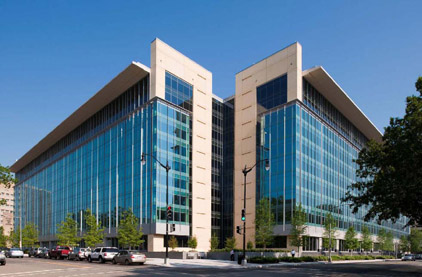
|
| In AMAG’s Symmetry Homeland Security Management System, Constitution Center, the largest privately owned building in Washington, found a solution that suited each of its tenants’ unique security requirements. PHOTO COURTESY OF AMAG |
Occupying a full city block a short distance from Capitol Hill, the Mall and several federal agencies, the Constitution Center is the largest privately owned building in Washington. The building was completely renovated between July 2007 and December 2010 and is now fully leased by the Office of the Comptroller of the Currency, the Federal Housing Finance Agency and the General Services Administration.
When looking at how they could better manage their new tenants’ needs, the building’s owner, David Nassif Associates, and its managing general partner, Timothy Jaroch, faced the decision of continuing to use the existing access control system or consider a security management system that could work with competing providers’ equipment. Jaroch decided to partner with Allegiance Security Integration (ASI), which suggested converting the existing system to AMAG Technology’s Symmetry Homeland Security Management System, which was agnostic and could grow with Constitution Center as it added more readers and cameras to its system. Symmetry Homeland also met Constitution Center’s requirement to be HSPD-12 compliant, a federal government mandated security standard for secure and reliable forms of identification.
“Constitution Center needed to take control of its security destiny, so I recommended AMAG’s Symmetry Homeland SMS,” said ASI’s CEO Aaron Welling. “That would allow security staff to respond to alarms immediately and provide better security for the building and tenants.”
With installation completed in May 2013, Symmetry controls access on all doors and turnstiles at the street level of the building. There are three ways into the building that include two main lobbies (one near the Metro and one at the main entrance on 7th Street) and the loading dock. Both main entrance lobbies are protected by cameras streamed through Symmetry, and a full-time armed guard.
Normal protocol allows employees to enter through one of multiple doors and swipe their government-issued Personal Identify Verification (PIV) card to proceed through the Symmetry-monitored turnstiles. If a person does not have a card, they have to proceed through visitor screening and be issued a visitor badge by the security desk. Once issued a photo visitor ID badge based on their driver’s license, they proceed through an airport-like screening process in a side room and then walk through a magnetometer. After the screening, they go through the established visitor management protocol set up by the tenant. The loading dock is equipped with a reader and security screening process to ensure that only authorized individuals gain access to the building.
The elevators are also controlled by Symmetry. An employee must swipe his or her card on a reader inside the elevator cab, and it will take the person only to the floors where the employee has been granted access.
Visitor Management
Constitution Center was built in four quadrants around a central courtyard, with each quadrant having its own lobby. At the expense of each tenant agency, every lobby is equipped with a guard desk (with hours of coverage as chosen by the applicable tenant), in addition to the Symmetry Homeland Security Management System. This allows for each agency to further screen its own personnel and manage visitors.
Each agency utilizes Symmetry differently to manage visitors. One agency pre-schedules its visitors and personally greets and escorts them into that tenant’s space. A different agency may pre-schedule, but if the visitor passes the screening in the lobby, they are free to proceed to the appropriate elevator lobby.
Symmetry’s built-in visitor management feature allows security guards to check people in. After the tenant pre-populates the visitor in the system, the guard scans information from the visitor’s ID, including the photograph, and prints a non-credential, self-expiring badge sticker.
Video
Much attention was given during the design phase to providing highly integrated access control and video with several security inputs so the system would alarm “appropriately.” As a result, Symmetry integrated with Constitution Center’s OnSSI video management solution. The integration allows the guards to monitor every camera if they choose, or only areas in alarm, which is what is preferred. With 48 cameras stationed at the entrances, lobbies, elevators and parking areas to monitor activity throughout the building, when an incident occurs, the camera sends an image to Symmetry and it displays on the monitors. The design allows people in the new security operations center (SOC) to focus on live incidents or potential problems rather than watch a wall full of monitors all day.
“One of the basic decisions I made was to implement a much faster response to alarms than could be achieved if our system was being monitored remotely. I wanted a system that was monitored at the building, so response time was as fast as could be,” Jaroch said. “I did not want to have security guards sitting in the Security Operations Center watching screens all the time. Now, images are thrown up on the screen when there is an alarm. The guards in the SOC are not ‘dumbed out’ by watching images all day; Symmetry hits them over the head with a mallet electronically every time there is a real problem.
“AMAG’s Symmetry system offered the flexibility we were looking for,” Jaroch said. “It monitors agnostics, allows numerous different inputs, and integrates with different turnstiles. We didn’t have to go in one direction with products that were forced on us by someone’s proprietary system. Symmetry gave us more choices,” he added.
“We demonstrated the Symmetry Security Management System to each of the building’s tenants separately to show them the system and how it worked,” Welling said. “These are technically savvy people with security, and they were universally impressed and were quick to say it. It was the ultimate testament to hear them say it, and I am thrilled to have happy tenants for Constitution Center.”
Working With ASI
A successful installation not only needs a great product, but an integrator who is attentive to the customer’s needs. Established in 2007, Allegiance Security Integration (ASI) is an electronic security firmbased in the Washington region and is a division of Allegiance Management. ASI helps federal, industrial and commercial businesses with their most critical physical security needs, including access control, video surveillance, SCIF, intrusion detection and fire systems.
“ASI was terrific to work with,” Jaroch said. “If there was a challenge, they would face it head on and deal with it. Being a former Navy guy, I appreciated the fact that ASI acts like the military and got right down to business. They are the kind of people I Iike to work with; they are very proficient and won the respect of everyone else on my team. I’d recommend them very highly to anyone.”




